Types of Weeds with Their Picture and Name – Identification Guide
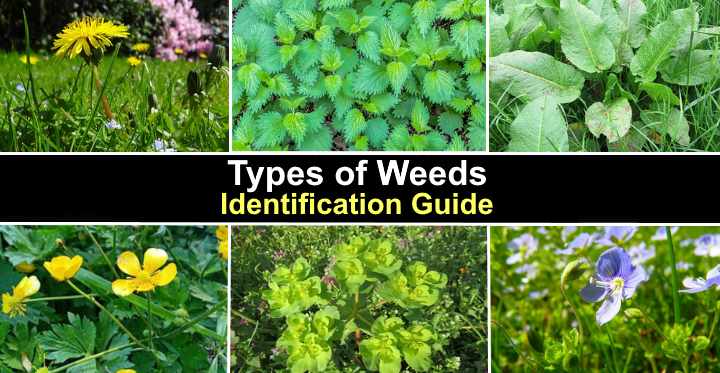
Weeds in your garden can spoil the appearance of your lawn, shrubs, and flowering plants. Weeds are generally invasive plants that spread quickly and grow where you don’t want them. Getting rid of weeds fast is vital to prevent them from taking over your garden. Garden weeds that are left to grow can develop extensive roots that make getting rid of them for good very challenging.
Some common types of stubborn perennial weeds like broad-leaved dock and dandelion have long taproots. These weeds will grow year after year unless you remove the whole root. Other broadleaf weeds like stinging nettle and Canada thistle have leaves that require removing them with protective gloves. There are also annual weeds that spread quickly when breezes distribute the weed seeds.
Preventing weeds from sprouting is typically the best way to control the unwanted plants from your garden. For example, sometimes, a layer of mulch is all you need to stop the pesky weed plants from growing in flower beds and shrub borders. In other cases, you need to carefully pull or dig up the weedy plant before disposing of it.
This article is a complete guide to the most common weeds you can find in your garden landscape. You will also learn how to identify grassy weeds that can spoil the appearance of your well-kept, lush lawn.
What Are Weeds?
Any unwanted plant growing in your yard can be a type of weed. Generally, common weed plants have undesirable qualities like invasiveness, jaggy leaves, or persistence. Weedy plants can also choke out desirable plants by competing for nutrients, light, and space. As a result, weeds make your garden look unkempt and messy.
Weeds generally fall into three categories—annual weeds, perennials, and biennial weed plants. Annual weeds that spread by seed can grow every year in new places. Perennial weeds produce long taproots and can be challenging to remove. Biennial weeds produce flowers in the first year and seeds in their second.
The two types of weeds are broadleaf plants and narrow leaf plants. Broadleaf weeds like dandelion or stinging nettle have large leaves and can have taproot or fibrous root systems. Narrow-leaved weeds are grassy plants that grow as tuft-like clumps of grass.
How to Identify Weeds
Proper weed identification is the first step to removing them. To identify weeds, look at the type of leaf, flower, and root system. For example, weeds tend to have a thick root, making them difficult to remove, or a creeping fibrous root system that spreads quickly.
Weeds spread easily and quickly and take root where you least want them. Weedy garden plants can be so prolific because they thrive in all types of soil.
Types of Weed Roots
Weeds are categorized by their roots. Typically, knowing the type of roots is key to controlling weeds and preventing them from ruining your hard work.
Here are four types of roots that weeds (and garden plants) have:
- Tap roots—The toughest garden weeds have long tap roots like a thin parsnip. Dandelions are a common weed with deep roots. The taproots tend to break easily, and any part left in the ground will grow again.
- Fibrous roots—Typically, annual weeds have thin, hair-like structures. Therefore, manual control of these weeds is easy because their shallow roots generally are easy to pull up.
- Creeping roots—Rhizome roots spread horizontally, sometimes up to many feet wide. Like removing tap roots, weeds with creeping roots are notoriously hard to remove.
- Bulb roots—Some flowering weeds have bulbous roots. The bulbils are usually easy to remove, but some bulbous weed roots break off in the soil, ready to grow again.
How to Get Rid of Weeds
Use an integrated weed management system to get rid of weeds. Natural weed killers include vinegar, salt, borax, or boiling water. To prevent lawn weeds, use a pre-emergent weed killer such as corn gluten that can keep lawn weeds at bay. Also, a layer of mulch in flower beds can prevent weed growth.
Related reading: How to get rid of weeds naturally.
Types of Weeds (with Picture and Name) – Identification Guide
Let’s look in detail at identifying the common types of weeds that can cause problems in your garden.
Stinging Nettle (Urtica dioica)
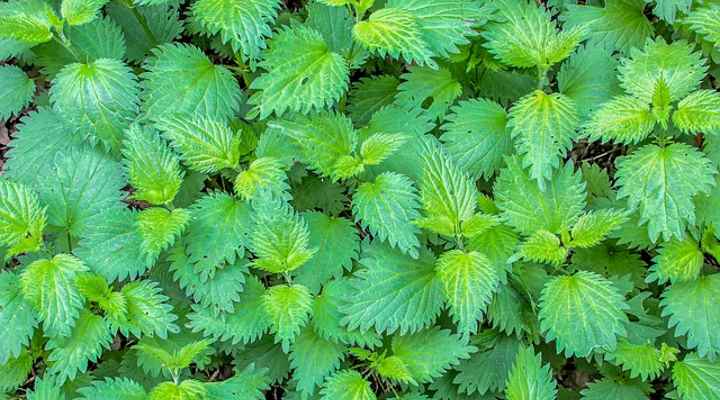
Stinging Nettle (Urtica dioica)
Stinging nettle is a perennial weed with green, tooth-edged ovate leaves and stinging bristles that cause skin irritation. Stinging nettles grow 3 to 10 ft. (1 – 3 m) tall, and the weedy stinging plant spreads through rhizome roots and airborne seeds.
Also called the common nettle, the weed’s roots can reach up to 5 ft. (1.5 m) wide and continue to grow if any part is left in the ground. Therefore, digging up the roots is the best way to control the spread and growth of the weed.
Weed Identification: Stinging nettle has identifiable ovate-shaped green leaves with saw-tooth margins and is covered in stinging hairs. Clusters of greenish-white flowers grow on the upper leaf stems.
Creeping Buttercup (Ranunculus repens)
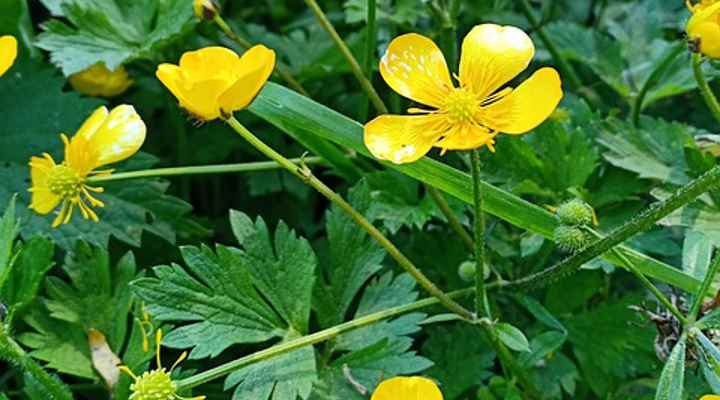
Creeping Buttercup (Ranunculus repens)
Creeping buttercup is a spreading garden weed with yellow flowers that can also become firmly rooted in lawns. The pesky weed spreads by long runners that form a robust network of stolons. Creeping buttercup commonly grows in damp ground and moist soil.
To get rid of creeping buttercup weeds, dig them up and destroy them. If the yellow-flowering weed has taken root in your lawn, use a wire rake to lift the runners before mowing the grass.
Weed Identification: Creeping buttercup has distinctive five-petalled yellow flowers and deeply lobed dark green leaves that resemble the shape of parsley leaves.
Spotted Spurge Weed (Euphorbia maculata)
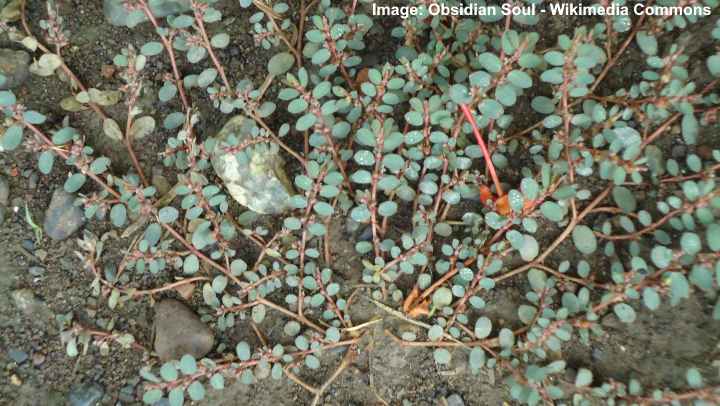
Spotted Spurge Weed (Euphorbia maculata)
Spotted spurge is a common weed that affects flower beds or lawns. This spreading weed has oval-shaped leaves on hairy reddish stems that form a ground-hugging mat of dark green foliage. The weedy flowering plant produces small pink flowers before distributing thousands of seeds.
Spotted spurge has a taproot, making complete removal of the invasive weed tricky. In addition, the weed has an irritating milky white sap—so, always wear protective gloves when hand pulling the weed.
Weed Identification: Spotted spurge is identified by small oblong leaves growing oppositely on fuzzy burgundy or copper-colored stems.
Broad-Leaved Dock (Rumex obtusifolius)
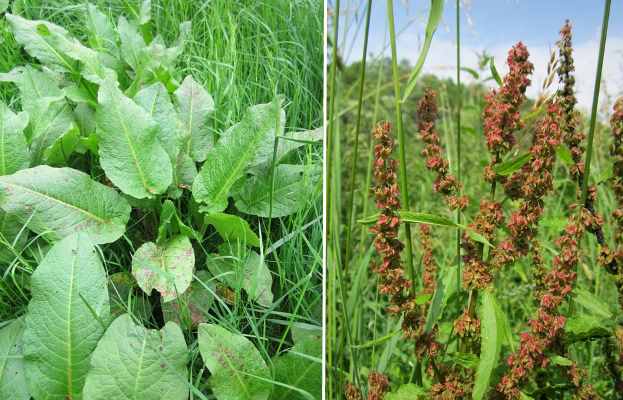
Broad-Leaved Dock (Rumex obtusifolius)
Broad-leaved dock is a troublesome weed with broad leaves that have a rounded or pointed apex and cordate base. Also called butter dock or bitter dock, the aggressive weed has long taproots up to 2 ft. (0.6 m) deep. Dock weeds have flowering stems up to 5 ft. (1.5 m) tall.
Weed Identification: Broad-leaved dock has distinctive lanceolate or ovate leaves up to 12” (30 cm) long on reddish stems. The sizeable leafy foliage has wavy margins and grows in characteristic clumps in flower beds and lawns.
Creeping Speedwell (Veronica filiformis)
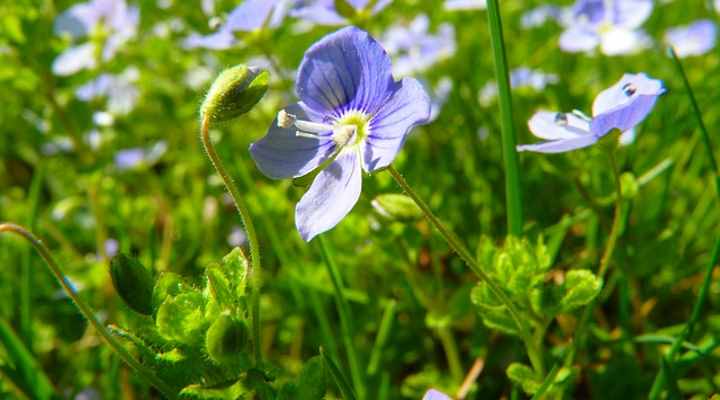
Creeping Speedwell (Veronica filiformis)
Creeping speedwell is a mat-forming spreading perennial weed with purple flowers. Although creeping speedwell produces pretty flowers, its fast growth means it can quickly get out of hand in borders and lawns. The four-petalled purple flowers grow on the end of long stems.
Creeping speedwell spreads through rhizomes and stolons. The creeping stems readily root where the nodes touch the soil. The best way to control the weedy speedwell is to rake as much of the plant as possible.
Weed Identification: Creeping speedwell is identified by glossy green, kidney-shaped leaves growing on short stems. The light purple flowers with a white tip bloom in spring and summer.
Common Self-Heal (Prunella vulgaris)

Common Self-Heal (Prunella vulgaris)
Common self-heal is a tough, spreading perennial purple weed with creeping stems producing edible, green, egg-shaped leaves on long slender stalks. The weed blooms from spring until fall, and the flowers appear as bluish or purplish flowers growing in a cylinder cluster. Common self-heal quickly spreads by its stems rooting on the soil.
Weed Identification: Common self-heal has characteristic cylindrical purple-bluish tubular flowers growing at the ends of erect stems. The leaves are grayish-green, lanceolate, and up to 4” (10 cm) long.
Types of Common Garden Weeds (with Picture and Name) – Identification Guide
Dandelion (Taraxacum officinale)
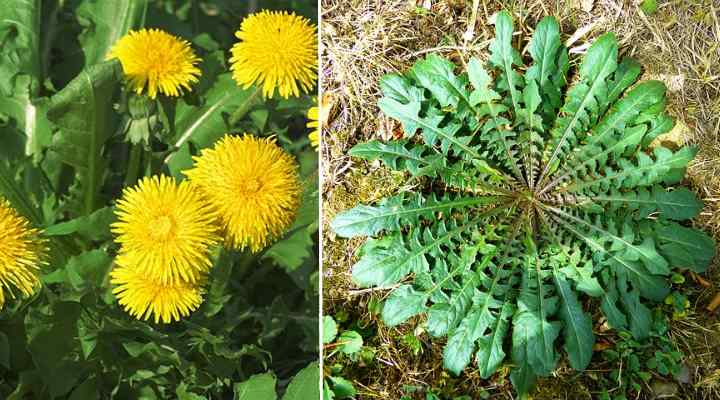
Dandelion (Taraxacum officinale)
Dandelion is a persistent, edible yellow flowering weed with oblong leaves, a rounded apex, and heavily lobed margins. Dandelion leaves are easy to spot in lawns or flower beds because they grow in a rosette pattern. Dandelions also have characteristic yellow flowers that turn into puff-like seed balls containing hundreds of seeds.
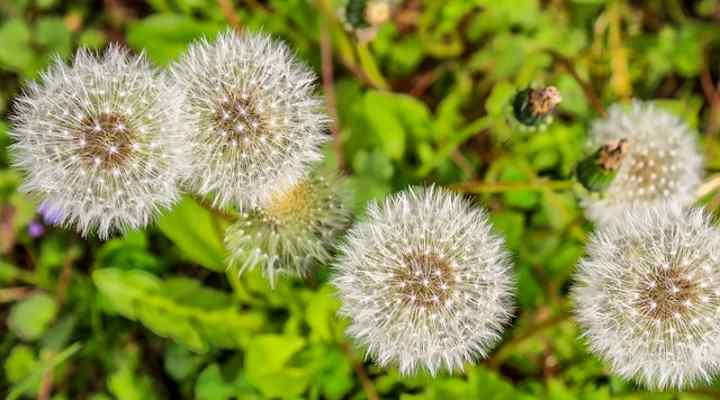
Dandelion seed heads
Dandelion is difficult to eradicate due to its deep taproots. In addition, the roots break easily when trying to dig them up. To prevent dandelions from becoming a nuisance, lay organic mulch in flower beds to prevent growth.
Weed Identification: Dandelions have recognizable green leaves with deeply toothed margins. The golden-yellow dandelion flowers have thin petals that form a circular disc-shaped ray.
Dandelion is one of the most common yellow flowering lawn weeds.
Broadleaf Plantain (Plantago major)
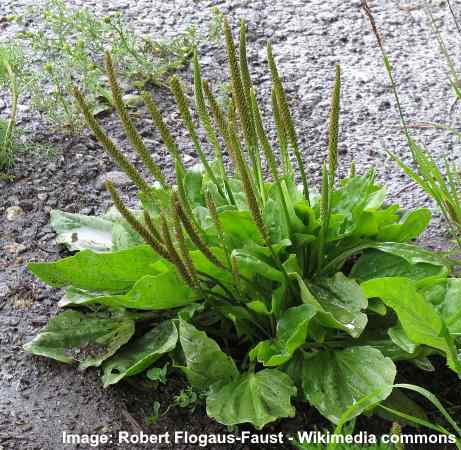
Broadleaf Plantain (Plantago major)
Broadleaf plantain is a hardy weed with broad leaves, yellowish-green flowers on long spikes, and invasive nature. The oval leaves grow up to 12” (30 cm) in diameter and have smooth edges. Plantain leaves grow close to the ground, making them difficult to remove by mowing lawns.
Also called white man’s foot, the tough weed has fibrous roots and thrives in compacted soil. It often grows through cracks in sidewalks or paved driveways. Digging up all parts of the roots is the best way to clear yards from these unwanted weedy plants.
Weed Identification: Broadleaf plantain has easily identifiable large oval or egg-shaped leaves that grow almost flat on the ground in a rosette pattern.
White Clover (Trifolium repens) and Red Clover (Trifolium pratense)
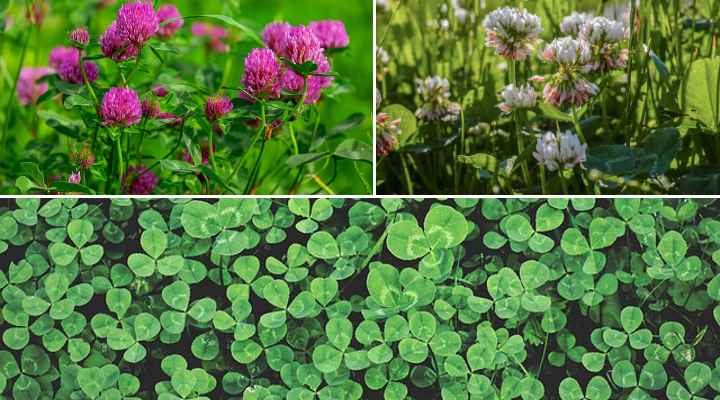
Red clover (Trifolium pratense) and white clover (Trifolium repens)
Some people view clover as an unwanted garden flower or an annoying flowering lawn weed with white or magenta flowers. The mat-forming creeping plant has invasive growth and can quickly spread over gardens. The creeping weedy stems produce globular flowers and small trifoliate leaves (leaves with three parts).
One of the best ways to control clover in a lawn is to keep a healthy lawn. Regularly fertilize your lawn with nitrogen-rich lawn fertilizer. You can also remove clover from a lawn with a rake by pulling up its creeping stems. In addition, setting your lawnmower to leave the grass a little longer can help prevent clover from growing in lawns.
Alternatively, you can find out about the benefits of growing a clover lawn.
Weed Identification: Clover has easily identifiable green leaves consisting of three leaflets and small white spherical white or red flowers. Red clover has white markings on light green leaves.
Hairy Bittercress Weed (Cardamine hirsuta)
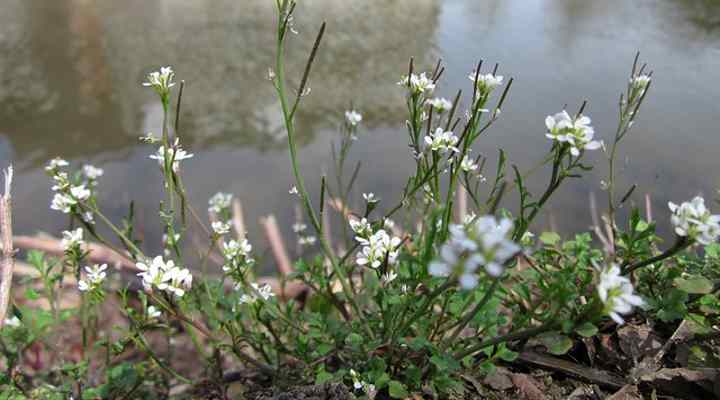
Hairy Bittercress Weed (Cardamine hirsuta)
Hairy bittercress is an annual white flowering weed that proliferates in spring. Hairy bittercress grows as small clumps of foliage with white flowers on the end of long stems. The deep taproot and thousands of seeds that the weed produces make it challenging to control.
To get rid of this pesky annual weed, use a long slim weeding tool to remove the deep root. Also, remove all flowers before they turn to seed. In some cases, you’ll need to use a chemical herbicide to kill the weed completely.
Weed Identification: Hairy bittercress is identified by its small hairy heart-shaped leaves growing clumps of rounded foliage. Tiny white flowers with cross-shaped petals bloom on the end of erect stems 10” (25 cm) tall.
Dollarweed (Hydrocotyle spp.)
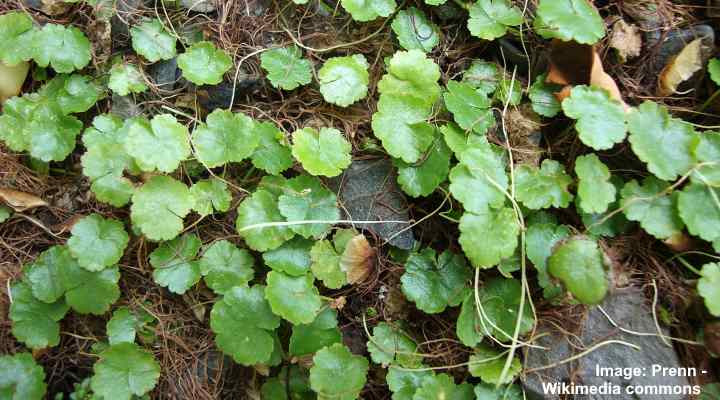
Dollarweed (Hydrocotyle spp.)
Dollarweed is a spreading perennial weed that is common in damp soil and lawns. This mat-forming weed also goes by the name pennywort. Dollarweed has rounded leaves in the shape of a silver dollar. The round leaves have scalloped margins with the stems in the center of the leaves.
Dollarweed thrives in soil or lawns that are nutrient deficient and waterlogged. To get rid of dollarweed, it’s usually necessary to improve soil health and reduce moisture levels in the ground. The weed spreads by seed and small rhizomes or tubers, and it’s easy to pull up the weed due to its shallow roots.
Weed Identification: Dollarweed has identifiable round, scalloped leaves that look like small lily pads. The fast-spreading weed produces small white flowers before releasing seeds.
Canada Thistle (Cirsium arvense)
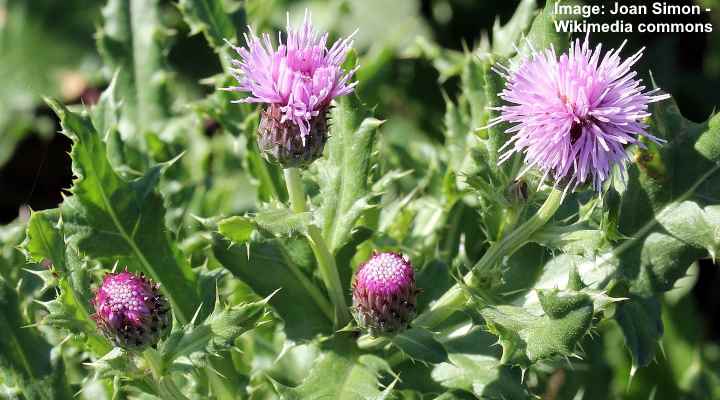
Canada Thistle (Cirsium arvense)
Canada thistle is a rapidly-growing spiky weed with purple flowers that thrives in a variety of soil conditions. Canada thistle’s leaves are prickly, lanceolate-shaped with lobed margins, and grow in a rosette pattern. The coarse spiny leaves require care when trying to pull the weeds out of the ground.
Also called creeping thistle, the jaggy purple flowering lawn weed is considered one of the most invasive weeds in the world. It is also classed a noxious weed.
Canada thistle weed is difficult to control because of the large, spreading roots. Rather than trying to pull Canada thistles from the ground, continually cut off new growth above ground to weaken the roots.
Weed Identification: Canada thistle has easily distinguishable prickly light green leaves that grow in tufts and produce purplish flowers.
Groundsel (Senecio vulgaris)
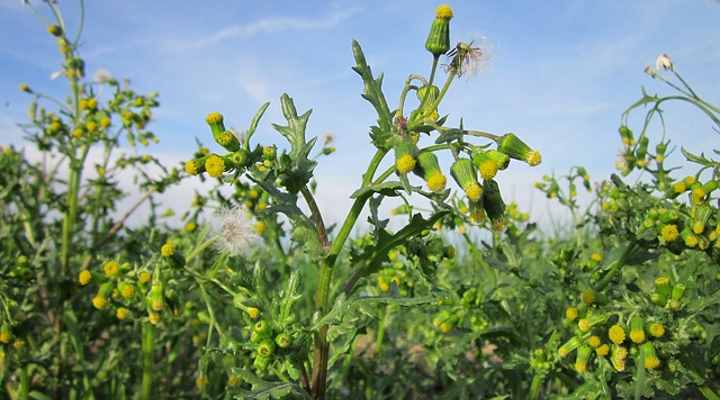
Groundsel (Senecio vulgaris)
Groundsel is a weedy annual plant that can spread quickly and take over gardens. The original name for the weed means “ground swallower,” which accurately describes its invasive speed. Groundsel has lanceolate leaves with lobed margins and a rough texture. The noxious weed also produces small golden-yellow disk-shaped flowers that look like dandelion flowers.
All parts of groundsel plants are poisonous, and the invasive weed can be dangerous for dogs, cats, and humans.
Weed Identification: To identify groundsel, look for sharply lobed thin oblong leaves that grow on erect stems 16” (45 cm) tall. The poisonous weed produces cylindrical yellow flower heads that turn into downy seed heads like a dandelion flower.
Types of Common Lawn Weeds
Common Daisy (Bellis perennis)
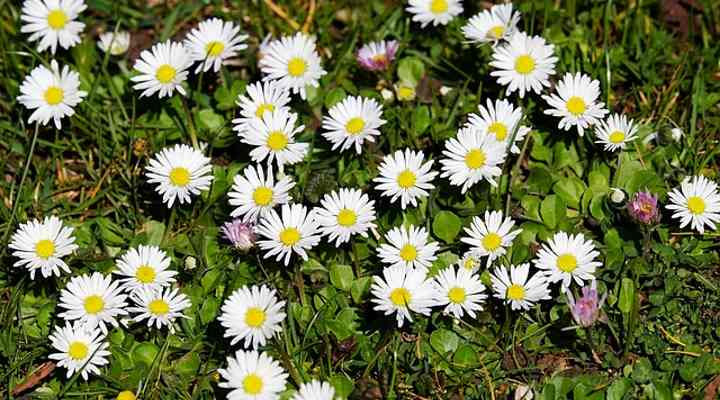
Common Daisy (Bellis perennis)
Also called lawn daisy, the common daisy is one of the most prolific flowering lawn weeds. Daisies have recognizable yellow and white ray flowers that grow among low-growing dense foliage. Daisy weeds spread through underground creeping runners. Daisies can become a pest in lawn grass because they tolerate regular mowing.
The best way to control daisies in lawns is by removing the weeds using a weeding tool like a daisy grubber and improving the health of your turfgrass.
Weed Identification: The common daisy has distinctive white and yellow flowers. Small white petals form a ray around a yellow center. Daisy leaves are identified by their spoon shape with lightly toothed margins.
Quackgrass (Elytrigia repens)
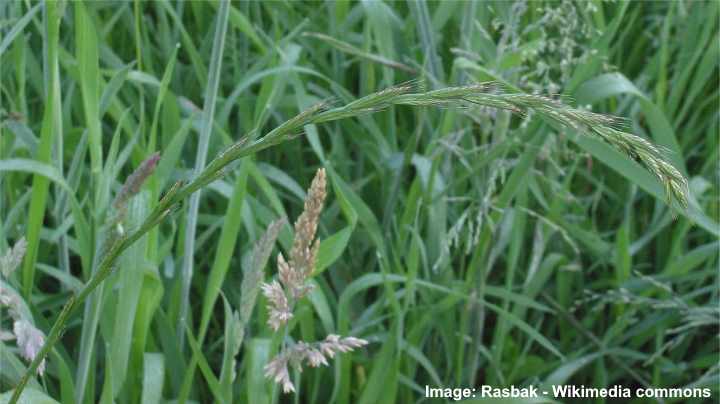
Quackgrass (Elytrigia repens)
Quackgrass is an invasive grass like weed that has distinctive broad grass-like blades with a rough texture. Quackgrass has thick, white roots that are difficult to pull up from flower beds and lawns. It’s vital to get rid of the persistent weed by removing it as soon as you see any new growth.
Crabgrass (Digitaria)
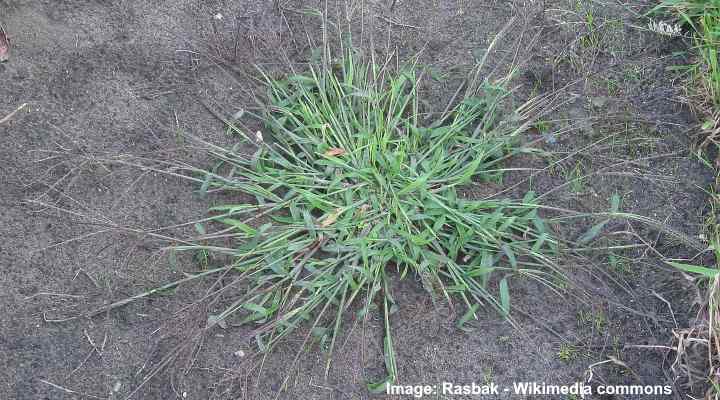
Crabgrass (Digitaria)
Crabgrass is a grass like weed that is identified by long, thin radiating branches growing on the ends of long stems among tufts of thin linear leaf blades. The best way to eradicate crabgrass from lawns is to ensure you have a healthy lawn. You can prevent crabgrass from growing by watering lawns correctly, providing enough nutrients, and ensuring proper drainage.
Dallisgrass (Paspalum dilatatum)
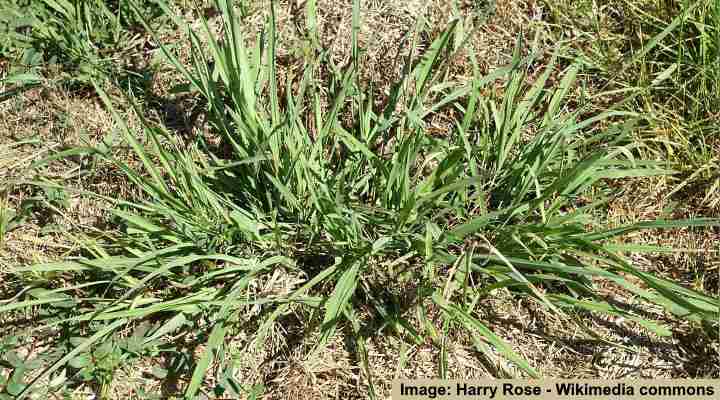
Dallisgrass (Paspalum dilatatum)
Dallisgrass is a common perennial lawn weed in warm climates that grows in unsightly grassy clumps in lawns. As a destructive weed, dallisgrass has coarse blades that grow up to 10” (25 cm) long. The tufts of annoying grassy weeds also produce small flowers growing at right-angles to the stems. Digging up all parts of the rhizome roots will help get rid of this turfgrass weed.
Burr medic (Medicago polymorpha)

Burr medic (Medicago polymorpha)
Burr medic is an invasive lawn weed with trifoliate foliage consisting of egg-shaped leaves with serrated edges. Burr medic also has identifiable reddish-purple stems and tiny yellow ball-like flowers that become prickly burrs.
Burr medic prevention is best done by a pre-emergent treatment such as corn gluten meal. Regular mowing also prevents the tiny yellow flowers from becoming seeds and spreading the annoying weed further.
Learn how to identify common flowering weeds.
Related articles:
